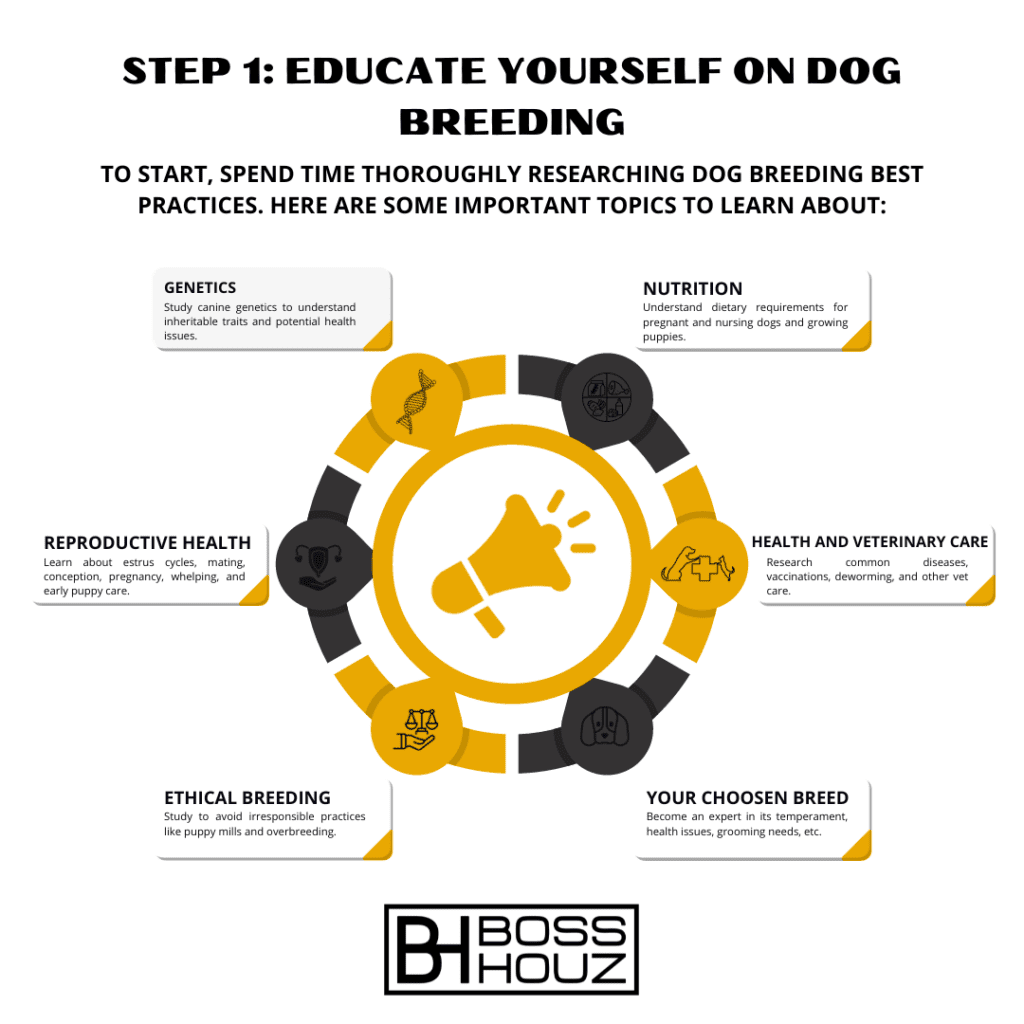Table of Contents
Overview of Starting a Dog Breeding Business
Starting a dog breeding business from home can be extremely rewarding for dog lovers, allowing you to work with dogs full-time and produce happy, healthy puppies. However, it also requires a major time commitment and responsibility. Proper education on breeding, investing in high-quality dogs, and focusing on animal welfare are all critical for success.
This article provides a step-by-step guide to starting a dog breeding business from home, including tips on choosing a breed, preparing your home, caring for puppies, marketing, record keeping, and more. We’ll also overview some pros and cons to consider before getting started.
Step 1: Educate Yourself on Dog Breeding


To start, spend time thoroughly researching dog breeding best practices. Here are some important topics to learn about:
- Genetics – Study canine genetics to understand inheritable traits and potential health issues.
- Reproductive health – Learn about estrus cycles, mating, conception, pregnancy, whelping, and early puppy care.
- Nutrition – Understand dietary requirements for pregnant and nursing dogs and growing puppies.
- Health and veterinary care – Research common diseases, vaccinations, deworming, and other vet care.
- Ethical breeding – Study to avoid irresponsible practices like puppy mills and overbreeding.
- Your chosen breed – Become an expert in its temperament, health issues, grooming needs, etc.
You can study books, take online courses, shadow reputable local breeders, and join breed clubs to continue expanding your knowledge.
Step 2: Choose a Dog Breed to Focus On
It’s best for beginners to focus on just one or two breeds. Consider:
- Breed popularity and demand – Cross-reference registration data from kennel clubs.
- Your personal experience and passion – Focus on a breed you’ve successfully owned before.
- Local availability – Avoid breeds that are already saturated in your area.
- Housing needs – Make sure your home/yard can accommodate the breed’s size and activity level.
- Health concerns – Understand common issues to breed responsibly.
Some examples of highly popular breeds are Labs, Golden Retrievers, French Bulldogs, and German Shepherds. But a less common breed can work too with the right marketing.
Step 3: Obtain Proper Licensing and Permits
Check your local and state laws to determine if you need any permits or licenses to legally operate a small-scale breeding business from your home. These may include:
- Business license and/or commercial breeder’s permit
- Sales permits and resale certificates
- Zoning approval for a home business
- Dog breeder permit from the Department of Agriculture
Failure to comply with regulations could result in hefty fines, lawsuits, or even prohibition of your breeding activity. Consult legal professionals if needed.
Step 4: Prepare Your Home and Supplies
To house your dogs, allocate an isolated room in your home just for them. This space should:
- Have easy-to-clean flooring and surfaces
- Be climate controlled with adequate temperature regulation
- Have designated potty areas like pee pads
- Accommodate crates, beds, toys, food/water bowls
You’ll also need:
- A whelping box for birthing puppies
- Play pens and baby gates to contain puppies
- Food, treats, supplements for optimal nutrition
- Grooming supplies like brushes, nail clippers, shampoo
- Cleaning products to sanitize surfaces and bedding
- Identification tags, collars, leashes for dogs
- Paper records to track lineage and health
Step 5: Find a Quality Breeding Pair
Search for dogs that:
- Are registered purebreds (AKC, UKC, etc.)
- Have documented pedigrees proving healthy lineages
- Have passed all recommended health clearances for their breed
- Have ideal temperaments and meet breed standards
- Are 2+ years old for females, 1+ year for males
Avoid inbreeding closely related dogs. Reputable breeders or breed clubs can help you locate dogs. Expect to invest $1000+ per dog for desirable traits.
For females, veterinarian approval for breeding is ideal. Check for fertility and that her growth plates have closed.


Step 6: Breed Your Dogs Responsibly
- Wait until the female is in heat to breed. Do not intentionally breed every heat cycle.
- Bring the pair to a stud service or mate on your premises. Supervise all interactions.
- Provide exceptional prenatal and maternal care including supplements and diet.
- Prepare for whelping with veterinarian guidance. Have emergency contacts.
- Allow dogs to whelp naturally but assist if vital issues arise.
- Never euthanize or cull puppies that appear unhealthy. Seek vet care.
- Socialize puppies immediately for positive temperament.
- Wean puppies properly starting at 3-4 weeks old.
Step 7: Care for the Puppies Properly
Until puppies are 8 weeks old and ready for their new homes you must:
- Monitor weight, temperament, and health vigilantly
- Deworm and vaccinate pups on schedule
- Feed high-quality puppy food 4-5 times daily
- Stimulate elimination and clean up accidents
- Handle pups frequently for socialization
- Give pups space to play/interact with mom and littermates
- Maintain optimal housing temperatures
- Prepare puppy packs with health records for new owners
Never separate pups from their mom before 8 weeks unless emergency vet care is required.
Step 8: Market and Sell the Puppies
- Create ads with available puppies and application forms.
- Post on classified sites, social media, and breed forums.
- Screen potential buyers thoroughly. Prioritize responsible homes.
- Charge fairly based on pup sex, color, confirmation, pedigree.
- Provide health certifications, vaccination records, contracts.
- Strive for 100% puppy placement in pre approved homes.
- Follow up with new owners to offer continued support.
Avoid selling puppies to pet stores or wholesale brokers/distributors. Vet all buyers.
Step 9: Keep Detailed Records
Maintaining accurate records is crucial for ethical breeding. Track:
- Dog registrations, pedigrees, health clearances
- Dates of heat cycles, breedings, whelp dates
- Litter details: number, sex, colors, weights
- Vaccinations, deworming, health issues
- Diet and supplements
- Expenses including veterinary fees
- Puppy sales dates, pricing, new owner info
- Breeding/ownership contracts and agreements
Thorough records help you monitor progress and make improvements.
Pros and Cons of Starting a Dog Breeding Business
Pros
- Opportunity to work full time with dogs
- Producing puppies for dog lovers
- Promoting responsible breeding
- Preserving and improving your chosen breed
- Revenue source from puppy sales
- Flexible schedule if breeding from home
Cons
- Substantial startup costs for quality dogs
- Intensive time commitment for puppy care
- Potential for heartbreak losing puppies
- Physical demands of handling dogs
- Cleaning and odor management
- Marketing not guaranteed to find buyers
- Stress finding suitable homes for puppies
- Ongoing costs for dog care and vet bills


Dog Breeding Industry Statistics
Growth of the Pet Industry
- The global pet care market has grown to $261 billion in 2022, up from $245 billion in 2021.
- An estimated 6.1% compounded annual growth rate (CAGR) is expected to increase the market size to $350 billion by 2027.
Ecommerce in the Pet Industry
- The online pet market has seen significant growth, nearly quadrupling since 2013.
- Ecommerce in the pet industry is expected to grow at 9.4%, increasing its market share beyond the current 13%.
Source: https://commonthreadco.com/blogs/coachs-corner/pet-industry-trends-growth-statistics
FAQs About Starting a Dog Breeding Business
How much does it cost to start a dog breeding business?
Startup costs range from $3000-$15,000+ depending on your existing infrastructure and the quality of dogs purchased. Ongoing costs for care, food, supplies can also be substantial.
What is the most profitable breed of dog to breed?
Based on both purchase price and litter size, some of the most potentially profitable breeds are French Bulldogs, English Bulldogs, German Shepherds, and Golden Retrievers. However, identifying local demand is key.
How much money can you make breeding dogs?
An average litter of 5-6 puppies can sell for $400-$600 per puppy. With 2-3 litters annually, dog breeding can produce $5000+ in gross revenue, although costs do add up. Larger operations can be more profitable through economies of scale.
Do you need a license to breed dogs?
Rules vary significantly by location. Most states require licensing for commercial breeders producing over a certain number of litters. Some states/cities require hobby breeder permits too. Research your local laws.
How often should dogs mate to produce puppies?
Females should only be bred during their biannual heat cycles. Allow them 12-18 months rest between litters. Avoid breeding very young or old dogs. Collectstud service can be used rather than over-breeding one male.








